
 Ministry
of transport and communication of Ukraine
Ministry
of transport and communication of Ukraine
Odessa National academy of telecommunications named after A.S.Popov
Communication Networks Department
Isdn. Main and additional kinds of service
1.Purpose of the work
Researching of the ISDN adapter possibilities by means of special software RVS-COM Lite. Set up of autoresponder, faxing by using an ISDN adapter and data transfer.
2.Key positions
Features and architecture of ISDN network
Integrated services digital network (ISDN) is a communication system with data, voice, and video transmission services, in which the main type of switching is channel switching and data are transmitted in digital form.
ISDN provides digitization of telephone network to transmit voice, text, graphics, music, video and other types of information to the end user and to receive it together from one terminal.
Important mean which provide the efficiency of the line usage is installing connect on demand -only for the duration of the session of data transmission. After its ending the physical connection is terminated. Unlike rented channels using communication channels on demand allows you to access the network or interrupt the link depending on the specific conditions or events which occurred on the network.
An important feature is the establishment of bandwidth on demand. When the bandwidth of one B channel exceeds the second connects automatically. To increase throughput by using PPP protocol, which is typically used to connect to the Internet, the standard Multilink PPP (MPPP) is developed. It allows to combine few B channels and create one logical channel with more bandwidth.
The structure of ISDN network is shown on Figure 1.
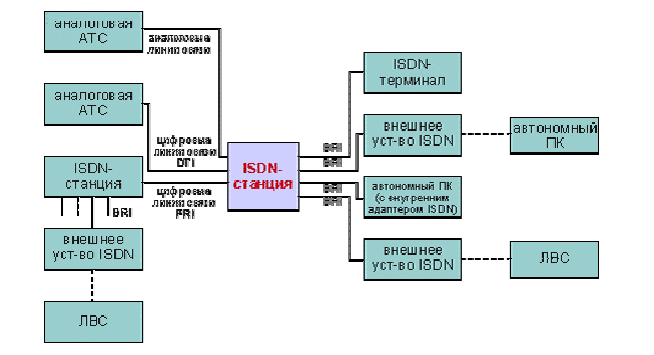
Figure 1- The structure of ISDN network
The main components of ISDN are:
-ISDN-stations (ISDN switches);
-ISDN terminals (digital telephones);
-internal ISDN adapter to connect a PC to ISDN network;
-external devices (blocks) to connect A PC to AN ISDN or LAN network as an alternative to adapters;
-blocks Network Terminator (NT1);
-communication lines (PRI and BRI interfaces).
There are two types of ISDN terminals. Dedicated ISDN terminals are called terminal equipment type 1, TE1. Terminals which are developed not for ISDN, such as DTE are called terminal equipment type 2, TE2. Terminals TE1 are connected to ISDN network by digital communication lines. Terminals TE2 are connected to the ISDN through a Terminal Adapter, TA.
Terminal ISDN adapter can be either a stand-alone device or circuit boards inside TE2. If TA is implemented as a standalone device, it is connected to TE2 through a standard interface of the physical layer (e.g. EIA232, v.24 or v.35).
The next point of connection in ISDN which is outside devices TE1 and TE2 is network terminal NT1 or NT2.
NT1 form digital subscriber line (DSL) which connects customer equipment with ISDN network. In most cases the NT1 is part of the network equipment, so customer equipment is manufactured without built-in NT1.
Nt2 are more complex devices of channel or data link level, which provide the concentration of user interfaces and their multiplexing. This type of equipment is the PBX, switching several interfaces BRI.
There is certain number of check points standardized in ISDN. These checkpoints provide logical interfaces between functional groups, such as the NT1 and TA. Check points of ISDN are "R" (checkpoint between non-specialized equipment TA and ISDN), "S" (check point between the user Terminals and NT2), "T" (check point of the NT1 and between devices NT1 and NT2) and "U" (check point between devices NT1 and the equipment of line shutdown in the commercial communication networks). The check point "U" corresponds to the connection of NT1 device to the network (see Figure 2).
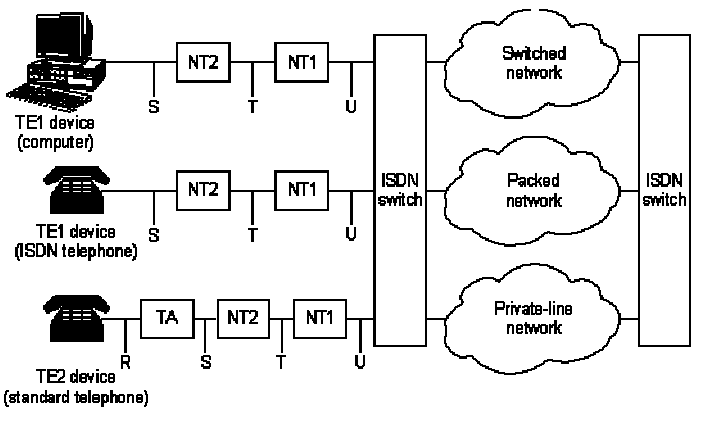
Figure 2-ISDN configuration example
BRI and PRI Interfaces of ISDN. Conformance to the levels of the OSI reference model.
There are two types of interfaces in ISDN network: BRI (Basic Rate Interface), and PRI (Primary Rate Interface). BRI offers two B-channel and one D-channel (2B + D). The bitrate of one B-channel is 64 kbps. These channels are used for payload transmission.
Bitrate of one D-channel BRI is 16 kbps. It is designed to transfer signaling and service information, although in certain circumstances, can support the transfer of user information.
Interface ISDN PRI:
• 23 B-channels and one D-channel in North America and Japan, provide total bitrate 1.544Mbit/sec. D-channel PRI bitrate is 64 kbit/sec.
• ISDN PRI interface in Europe requires 30 B-channels and one D-channel of 64 kbit/sec, and total bitrate of interface is 2.048 Mbit/sec.
Level 1 of the OSI model
Formats of data block in physical layer1 (see Figure 3) ISDN differ depending on a block of data sent outside the Terminal (from terminal to network) or within the limits of the Terminal (from network to Terminal). The length of the data block is 48 bits, of which 36 bits are user information. Bits of "F" provide synchronization. Bits "L" regulate the average value of bits. E-bits are used to resolve conflicts when several terminals in a passive bus compete for one channel. Bit "And" activates the device. Bits "S" have not yet been appointed. Bits "B1", "B2" and "D" are intended for user data and management accordingly.
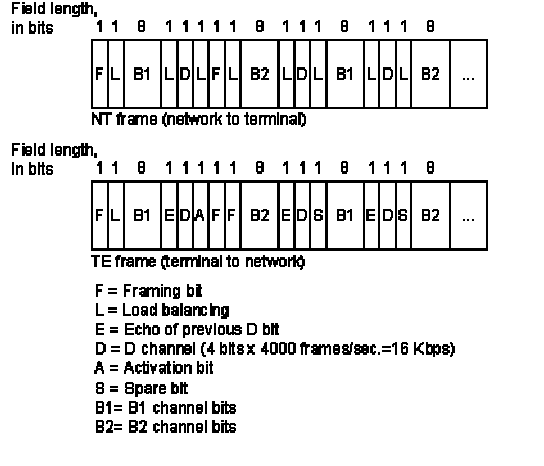
Figure 3-Format of the frame of the ISDN physical layer
Physically to the one circuit many ISDN user devices can be connected. For such configuration the collisions may be result of the simultaneous transfer of the two terminals. Therefore, ISDN provides means to identify conflicts in the communication channel. When a device NT receives bit D from TE it reflects this bit as echo signal back to the neighboring position of E-bits. TE expects that the neighboring E-bits must be the same as the bit D from the last transmission.
Terminals cannot transmit in the D-channel as long as they do not recognize a specific number of units (indicating "no signal"), with predetermined priority. If TE device detects a bit in the channel with echo signal (E) other than its bits (D), it should immediately stop transmission
This simple technique ensures that only one terminal may transfer its D-message. After a successful transfer of D-messages priority of this Terminal becomes lower, it is provided through presentation of the claim before transmissin to detect more units. Priority of the terminal may not increase until all other devices on this line will not be able to send D messages. Telephone connections have the biggest priority than other services, and signaling information takes precedence over the nonsignaled.
Level 2 of the OSI model
Protocol of the level2 of ISDN signaling is LARD. Format of frame LAPD is presented in Figure 4.
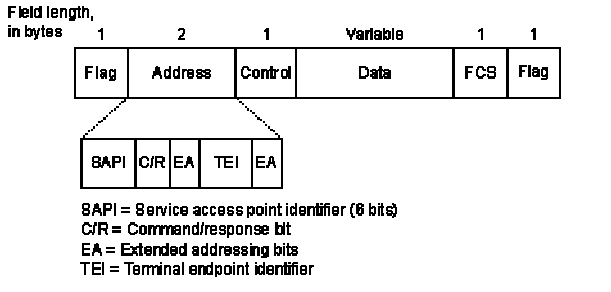
Figure 4-Format of the LAPD frame
Fields flag and control of LAPD are identical to those fields in HDLC. Length of the field "address" LAPD might be one or two bytes. If the bit of extended address (EA) is in the first byte, the address is a single byte. If it is not, the address consists of two bytes. The first byte of the address field contains the service access point identifier (SAPI) that identifies the main input, where services are provided by LAPD to level 3. Bit C/R indicates whether a data block contains command or response signal. The field terminal end point identifier (TEI) indicates whether the Terminal only one, or a lot of them. This identifier is the only one listed above, which indicates the broadcast.
Level 3 of the OSI model
The Figure 5 shows the ISDN switching stages which correspond to the 3rd level of the OSI.
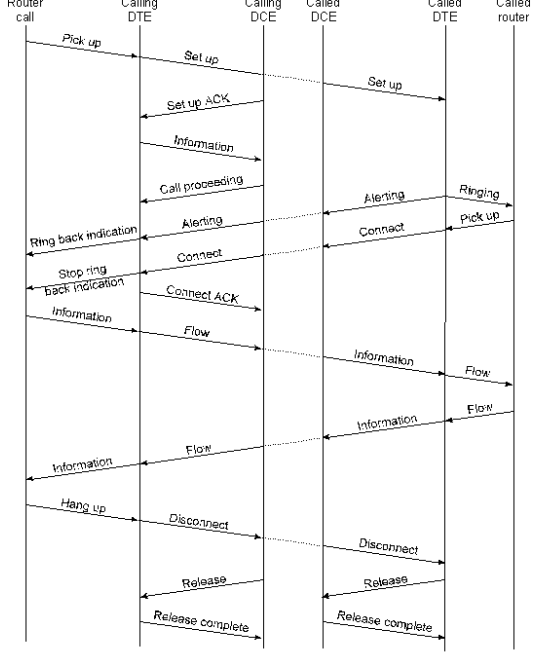
Figure 5- ISDN switching stages
ISDN service messages are defined here, such as SETUP, CONNECT , DISABLED, USER INFORMATION, CANCEL, STATUS and DISCONNECT. These messages are functionally similar to messages, which ensures the x.25 protocol.
Services of ISDN network
Services can be divided into two categories:
• Services in the terminal device that does not require access to data in another network devices;
• Services provided by the network that require access to the switching nodes or other devices on the network.
ISDN services:
-ISDN telephony 3.1 kHz;
-ISDN telephony 7 kHz. Similar to the telephony 3.1 kHz, but in the terminal equipment is special coding to allow bandwidth 7 kHz at a bitrate 64 Kbit/s;
-TV services (levels 4 to 7 of the OSI model)
-Fax Gr. 2/3;
-Fax Gr.4. Service ensures the transfer of an A4 page in less than 10 seconds with a resolution of 300-400 dots per inch. Possible compatibility with fax Group 3;
-Teletext 64 Kbps. It enables users to share business correspondence in documentary form. When you use service for transferring pages A4 it will require approximately 1 sec;
-Videotext. The service provides a more effective transfer of text and graphical information in a mixed way. Generating time of images on the screen with transmission speed of 64 kbit/s is 2 seconds;
-Video telephony.
